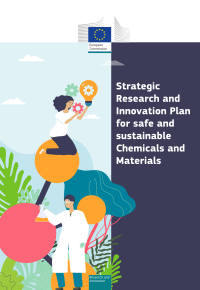The Chemicals Strategy for Sustainability (CSS) announces a Strategic Research and Innovation Agenda in 2022. The current Strategic Research and Innovation Plan (SRIP) delivers on this announcement and highlights current research and innovation (R&I) areas crucial for accelerating the transition to chemicals and materials that are safe and sustainable.
This SRIP is a result of extensive consultations with different stakeholder groups and reflects the R&I needs flagged during these consultaions. It provides a comprehensive outlook of R&I needs for chemicals and materials across their lifecycle, i.e., from production to (re)use, disposal and pollution remediation. Chapter 3 outlines the key enablers and cross-cutting aspects crucial for maximising the impact of future research. Chapter 4 lists the R&I challenges linked to the design phase and builds on the work done in developing the safe and sustainable by design framework for chemicals and materials. Chapter 5 focuses on safe and sustainable production processes. The use stage of chemicals and materials requires R&I to enable a reliable assessment of functionality, performance, safety and sustainability, including exposure monitoring and modelling (Chapter 6) as well as hazard (Chapter 7) and risk assessment (Chapter 8). R&I needs related to the end of life of chemicals and materials emerging from the need to decontaminate and remediate pollution are addressed in Chapter 9. Chapter 10 sets out a monitoring scheme for the SRIP implementation.
The aim of the SRIP is to guide R&I funders in their decisions on investments across EU, national and private funding programmes. It is an opportunity for a more transparent communication among all relevant actors on joint R&I priorities proposed by the wider community: from academia to SMEs, large-scale industry, regulators and policymakers.
The Commission will refer to this SRIP in the Horizon Europe work programme as an overarching strategy. In addition, the Commission invites research and innovation funders across EU, national and private funding programmes as well as researchers and innovators to support this strategy and to contribute to its implementation.
- FAIR data and open platforms
- Validation and standardised test guidelines
- Skills, education and training
- Green and innovative business models
- Modelling and characterisation
- Life-cycle assessment
- Development of safe and sustainable by design alternatives
- Sustainable supply of primary raw materials
- Sustainable supply and recycling/upcycling of secondary raw materials
- Clean, green and efficient production processes
- Exposure monitoring
- Exposure models
- Integrated hazard assessment
- Mechanism based methods
- Toxicokinetic data
- (Eco)toxicity models and tests
- Substance specific
- Mixtures
- Databases
- Data analysis
- Decision support and guidelines
- Inclusion of exposure data
- Grouping of chemicals
- Improved methodologies and tools
- Targeted approaches
- Information sharing
- Risk mapping
- Trust building and risk communication
- Risk analysis and management of existing pollution
- Monitoring pollution
- Remediation strategies
- Decontamination and treatment techniques
- Storage of contaminated materials
- Cost-benefit balance

